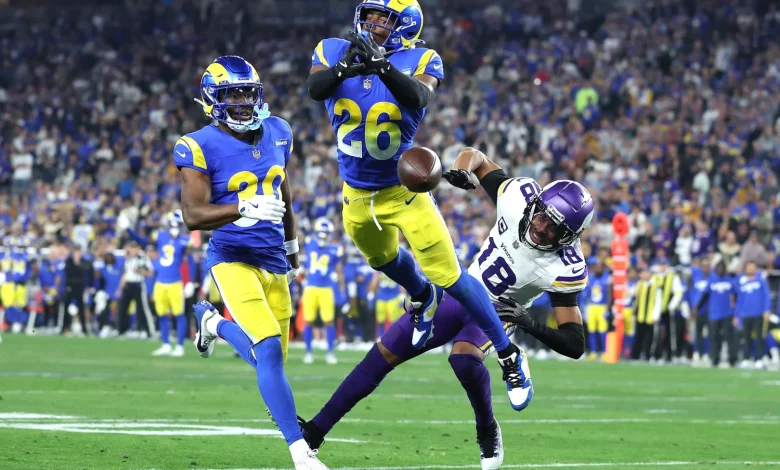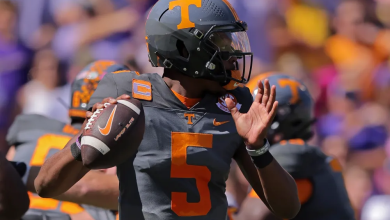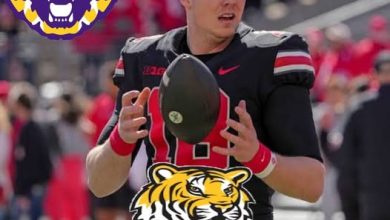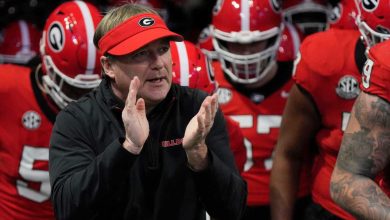NFL Playoffs: After fires forced the game to be moved, the Los Angeles Rams defeated the Minnesota Vikings

The NFL Playoffs are always filled with excitement, high-stakes drama, and some of the most thrilling moments in sports. The postseason is the time when teams face off for a chance to cement their place in history as one of the NFL’s elite squads. However, this year’s playoff scenario was marred by an unexpected disruption—wildfires that led to the relocation of a pivotal game between the Los Angeles Rams and the Minnesota Vikings. Despite the extraordinary circumstances surrounding the game’s venue change, the Rams emerged victorious, defeating the Vikings in a game that was much more than just a playoff matchup. It was a testament to the resilience of both teams and their ability to adapt to challenging situations.
The move from a traditional home game to a neutral site location is an unusual event in the NFL. While weather-related delays and stadium issues are not uncommon, natural disasters like wildfires are a rarity. The Rams and Vikings were forced to play on unfamiliar ground, far from their loyal fanbases. Still, both teams rose to the occasion, delivering a game that will be remembered for its high intensity, emotional moments, and ultimately, the Rams’ impressive victory.
The Wildfires and the Impact on the Game
In the days leading up to the playoff game, wildfires in California, particularly in the Southern California area, became an ever-growing threat. The intensity of the fires forced local authorities to issue evacuation orders in certain areas and even prompted warnings for nearby cities. Wildfires are a natural part of life in California, but the severity of this year’s blazes forced the NFL to make a difficult decision.
With the Los Angeles Rams scheduled to play the Minnesota Vikings at their home stadium, the SoFi Stadium, in Inglewood, California, it was clear that the situation would require a change in plans. SoFi Stadium, like many other stadiums in the region, was located in a zone impacted by the smoke and fire danger. The air quality in the area had deteriorated to dangerous levels, with smoke posing a health risk to the players, staff, and fans. Although the stadium itself remained physically safe, the decision was made to relocate the game for safety reasons.
The NFL’s quick response to the situation involved moving the game to a neutral site in an area deemed safe and free from the wildfires’ effects. This decision, though necessary, presented a unique set of challenges for both teams. Traveling to an unfamiliar location and dealing with the added stress of a disrupted routine is never easy, especially when you are in the midst of a high-stakes playoff atmosphere. However, both the Rams and Vikings knew that they had to focus on what was on the field, not the circumstances around them.
The Relocation of the Game: Neutral Ground and New Challenges
The game, originally set to take place in SoFi Stadium, was moved to Allegiant Stadium in Las Vegas, Nevada. Allegiant Stadium, home to the Las Vegas Raiders, is a state-of-the-art facility and offered a neutral site for both teams to compete. While Allegiant Stadium had the amenities and infrastructure to host a high-profile NFL playoff game, the move introduced new dynamics into the equation.
First and foremost, both teams had to travel, creating a logistical challenge. The Rams, based in Los Angeles, were used to playing in their home stadium, while the Vikings had planned for a road playoff game. The shift to a new city also meant that fan bases would not be as strong in numbers. The neutral setting took away the home-field advantage that either team could have counted on in a playoff atmosphere, making this game as much about mental toughness as it was about physical execution on the field.
For the Rams, the move to Las Vegas felt particularly ironic. The team had been through a lot of transitions in recent years, from their relocation from St. Louis to Los Angeles to their quest for another Super Bowl title. Now, as they were in the thick of the playoffs, they found themselves playing in an unfamiliar stadium under circumstances beyond their control. However, Sean McVay, the Rams’ head coach, instilled a mentality of focus and adaptability in his team. He reminded his players that regardless of the circumstances, they had prepared for this moment for months.
The Vikings, led by head coach Kevin O’Connell, found themselves in a similar position. Minnesota had been playing solid football all season, earning a playoff berth with strong performances from quarterback Kirk Cousins and the defense. However, the disruption of a neutral-site game certainly posed a new challenge. For a team that was used to playing in the cold confines of U.S. Bank Stadium, the shift to a neutral location with no clear advantage of home field required mental adjustment. But like the Rams, the Vikings had no choice but to focus on execution and teamwork.
The Rams’ Dominant Performance: Breaking Down the Victory
Despite the external distractions, the Los Angeles Rams stepped up when it mattered most, securing a decisive victory over the Minnesota Vikings. The game ended with a final score of 31-17, and while both teams had their moments, it was clear that the Rams had been the more complete team on the day. Let’s break down the critical elements of their success.
- Offensive Firepower:
The Rams’ offense was humming from the outset of the game. Matthew Stafford, who had faced criticism earlier in the season for inconsistent play, delivered a poised and sharp performance. Stafford threw for three touchdowns and over 300 yards, spreading the ball around to multiple receivers. Cooper Kupp was once again Stafford’s go-to target, with Kupp catching a touchdown pass and making crucial third-down conversions. The Rams’ offensive line also stepped up, giving Stafford the protection he needed to survey the field and execute the offensive game plan.
One of the standout moments came from Cam Akers, who provided a solid running game to complement Stafford’s passing attack. Akers rushed for over 100 yards and scored a touchdown, helping to keep the Vikings’ defense honest and maintaining a balanced offensive attack. This was particularly important as the Rams knew they needed to establish the run to keep the Vikings’ pass rush at bay. The combination of Stafford’s passing and Akers’ running provided the Rams with a potent offensive attack that proved too much for Minnesota to handle.
- Defensive Dominance:
On the defensive side of the ball, the Rams were relentless. The Rams’ defense, led by Aaron Donald, was able to stifle the Vikings’ offensive game plan. Donald’s presence was felt throughout the game, and he disrupted Minnesota’s offensive line, registering a sack and forcing Kirk Cousins to rush his decisions in the pocket. The Rams’ secondary also played a critical role, with Jalen Ramsey and Darious Williams locking down the Vikings’ wide receivers.
The defense was particularly effective against Cousins, who struggled to find a rhythm. While Cousins was able to throw for some yards, he was unable to sustain any long drives, and key turnovers in the game ultimately sealed the Vikings’ fate. A timely interception by Ramsey in the second half allowed the Rams to extend their lead, and they never looked back. The defense stood firm, stopping Minnesota’s offensive attacks on crucial third downs and limiting their scoring opportunities.
- Special Teams:
The Rams also had a standout performance on special teams. Kicker Matt Gay was perfect on field goals, converting all of his attempts, including a 50-yard kick that added three crucial points. Johnny Hekker, the punter, had several excellent punts that pinned the Vikings deep in their own territory, allowing the Rams’ defense to assert its dominance. Special teams play is often the unsung hero in playoff games, and the Rams certainly benefitted from a solid showing in this area.
- The Vikings’ Struggles:
On the other hand, the Minnesota Vikings struggled to find their rhythm throughout the game. Kirk Cousins, despite putting up decent numbers, was unable to lead his team to sustained success. The Rams’ pressure and strong secondary play limited Cousins’ ability to find open receivers consistently, forcing him to make hurried throws. Dalvin Cook, who had been a key component of the Vikings’ offense throughout the season, was kept in check by the Rams’ defense, rushing for less than 70 yards on the day.
The Vikings also had several critical miscues, including a fumble by Cook that was recovered by the Rams, leading to another scoring opportunity. Additionally, the lack of a strong performance from Minnesota’s wide receivers hindered the Vikings’ ability to capitalize on short-yardage situations and convert key third downs.









